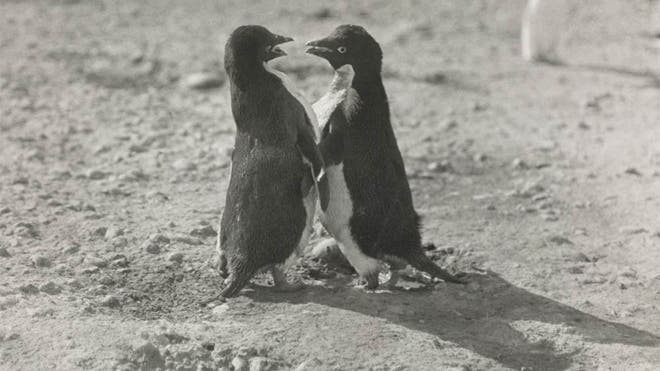Hidden for more than 100 years for being too ‘graphic’, a set of images depicting ‘hooligan behaviors, including sexual coercion’, sodomy and necrophilia by Adelie penguins observed during captain Scott’s 1910 expedition were revealed, analyzed and interpreted.
George Levick, a surgeon and the medical officer on Scott’s famous 1910-1913 expedition to the South Pole, called the Terra Nova expedition, detailed the above mentioned behaviors in a four page pamphlet – “Sexual Habits of Adélie Penguins” in 1915. However, aside from the fact that it didn’t get any scientific attention, even the pamphlet wasn’t published.
“As it was boldly headed ‘Not for Publication’ it immediately caught my eye,” Douglas Russell, who discovered the pamphlet, explained. “As the curator of birds eggs and nests at the Natural History Museum and having had a long-standing interest in polar research, I knew of George Murray Levick and that this was, as the header suggested, fascinating but totally unpublished work.”
Apparently, penguins are quite dirty fellows, and they’re into all kinds of weird stuff.
“Some of the things he noticed profoundly shocked him,” Russell said. For instance, Levick noted the penguins’ autoerotic tendencies, and the seemingly aberrant behavior of young unpaired males and females, including necrophilia, sexual coercion, sexual and physical abuse of chicks, non-procreative sex and homosexual behaviors.
The pamphlet was considered to be far to explicit for the days, and as a result, it never got published, and Levick didn’t insist on the matter, despite being way ahead of his time – or perhaps for this exact reason.
“Levick’s notes were decades ahead of their time and possibly the first ever attempt to reveal the more challenging aspects of bird behavioral strategies to the academic world,” Russell said in a statement.
Apparently, he was so shocked by these behaviors that he started recording his notes in Greek, in order to prevent them from falling into the wrong hands and being made a mockery of.
“There seems to be no crime too low for these penguins. [..] This afternoon I saw a most extraordinary site [sic]. A Penguin was actually engaged in sodomy upon the body of a dead white throated bird of its own species. The act occurred a full minute, the position taken up by the cock differing in no respect from that of ordinary copulation, and the whole act was gone through down to the final depression of the cloaca.”
Apparently, necrophilia isn’t nearly as low as penguins go; rape is relatively common, as is sodomy and homoeroticism. While homosexual animal intercourse would hardly make any biologist blush, at the time it was something unbelievable. Nowadays, many animals have ‘stepped out of the closet’, including dolphins and killer whales, as well as geese. Some estimate the number of these species to 1500.
However, one crucial mention has to be made here; while Levick viewed penguin acts through an anthropomorphic lens, now, researchers now this is not the case, not nearly. Necrophilia for penguins and for humans is totally different: rather than being sexually aroused, the penguin is chemically bond to respond to a seemingly compliant female of breeding age.
“I’m very pleased that, 97 years after Levick submitted it for publication, the study has finally been published,” Russell said. In fact, no other studies on this colony have been published, the researchers note.










